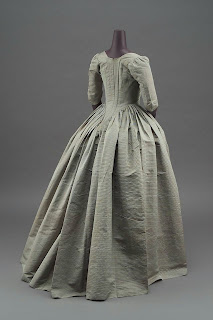I officially finished my shoes yesterday, so I figured I should finally catch the blog up to the process! Last time I had assembled the uppers and was beginning to work on the soles.
Once the sole is fleshed and cut down to shape, the "hold-fast" is put in. That's simply where the stitching area is. In this case, there's a 1/4" section around the outside which is cut down. A grove is opened up 1/4" in from that. The awl holes run between those two sections, fanning out around the toe.
Once the sole is finished the whole last is wrapped in paper. Since I'm working with a silk which will be up against it, there needs to be protection. Wet leather bleeds easily and other things can rub off of the wood and stain.
The upper is then lasted, inside-out. There's a specific process to this, starting with the heel up an inch, then lasting the toe and pulling the heel down. From there it's just a matter of working back and forth to remove the wrinkles and stretch everything tightly.
The paper around the sole is ripped off and stitching begins. The awl holes are extended into the uppers and opened up as much as possible without ripping out. The thread is actually 9 linen threads twisted with shoemakers wax and each hole has both ends passed through.
Once the stitching is finished, the extra allowance is cut back and hammered down. You can see the wrapped threads which are helping to hold the instep leather in it's place. They'll be cut for unlasting and turning.
At this point, the concept of turning looks impossible. The sole leather is wetted down carefully so it doesn't bleed into the upper to help.
Once a certain point is reached a stick of some kind is used to help turn. Carefully pushing left, right, center on the sole while gently pulling on the tongue.
Side view of turning. It's almost fully turned. You can see the paper which is sticking out of the stitching area. What can be seen/reached will be removed, but many originals have small paper scraps in this area.
Both shoes have been turned and the insoles have been cut down to shape.
The shoe on the right was my first and I made the awl holes too deep. You can see a "ladder" effect on the bottom.
The wooden heels were partially shaped, but much too large. Here it's been trimmed down to a proper shape.
The insole is prepared in a very similar way to the sole. The outside 1/4" is cut at an angle so there's no bump visible in the upper once finished. The front portion is also angled out to almost nothing on the edge, but it's much more gradual. There is also a peg holding the front portion in rather than the tack in the back. This allows for the insole and last to be inserted into the shoe at the same time. The small slit will allow the last to be pulled out easily in the end.
Paste is applied to the front portion of the insole and the last is inserted back into the shoe (with a lot of pushing and pulling). The sole is pulled back and tacked to keep out of the way.
I originally was going to make the heel cover out of the silk, however when it was tried it just wouldn't stretch and give enough to form the complex shape. So, it was removed and a whittaw heel cover was stitched on instead. The heel is pasted in and the leather is smoothed as much as possible over it using tacks and tape to draw the center down. There will also be some stitching back and forth along the front of the heel to pull the heel cover together.
Once the heel cover looks nice and the paste has dried, the sole is released and pounded (wet) to the shape inside the heel. A few tacks hold it temporarily.
The finished shoes! The sole has been trimmed back to a nice point, flush once it reaches the heel.
There is fine stitching to hold the sole to the heel cover. The wooden heel is held in because of this snugness and the paste. There are two pegs driven into the heel through the sole for a bit more stability. There is also a second piece of leather attached to the bottom of the heel. The first one is stitched on around the edges. The second one is only pegged on, making it more easy to remove when it wears out.
You can see how the stitching runs around the bottom of the heel cover.
There are many "issues" I can now see with my shoes. Nothing serious, but things I want to improve the quality of next time. The speed and quality of the second shoe was dramatically better, so hopefully things will continue to get easier every time. I'll be testing them out this weekend, so the final question of how comfortable they are will be well answered!


















































